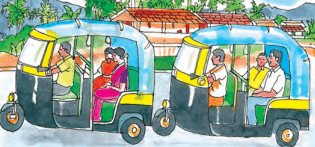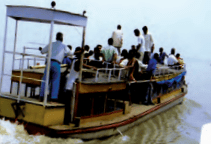Reaching Grandmother House Class 4 Notes EVS Chapter 8
| Table of contents |

|
| 17 May Night |

|
| Reaching the Water Side |

|
| Understanding the Journey |

|
| Reading a Railway Ticket |

|
| Using a Railway Time-Table |

|
| Word Meanings |

|
17 May Night
Omana and her family had a long journey to reach Kottayam. After getting off the train, they had to take two auto-rickshaws to go to Valiyamma’s house. Omana was very tired, so she didn’t eat anything and went straight to bed. But soon after, Amma woke her up because they had to continue their journey. They gathered their luggage and went to the bus stand. Omana’s whole family, ten people in total, were traveling together with a lot of bags and suitcases.
Bus Journey
Once they got on the bus, Omana’s father, whom she calls Appa, bought tickets for everyone. The bus became very crowded as it went on. People were even sharing seats because there wasn’t enough space for everyone to sit. After a long bus ride, they finally reached the last stop. Omana was so happy to get off because her legs were stiff and she could hardly stand. But even though they got off the bus, they still hadn’t reached their destination.
Reaching the Water Side
When they got off the bus, Omana realized they were by the water. Her Amma pointed across the water and said, “That is where we have to go.” Omana wondered how they would get there. Soon, she saw a boat called a ferry coming towards them. Amma explained that the ferry helps people cross the water to get to the other side. After the ferry emptied, everyone from Omana’s side rushed to get on it. They had to pay a fare to board the ferry. The ferry was very full, but Omana found a spot to stand by the railing. She watched as the ferry moved smoothly across the water, seeing coconut trees, people fishing, washing clothes, and even bathing along the banks of the river.
Arriving at Ammumma’s Place
Just before the sun went down, the ferry reached the island where Omana’s grandmother, Ammumma, lived. Omana was relieved and excited to finally reach Ammumma’s house after such a long and interesting journey.
Different Kinds of Transport
Omana used many different types of transport during her journey. After getting off the train, she traveled by auto-rickshaw, bus, and ferry. Each type of transport helped her get closer to her grandmother’s house.
Understanding the Journey
- Ticket Buying: Omana’s Appa had to buy tickets for the train and the bus. We often need to buy tickets when we travel by public transport, like trains, buses, and even ferries.
- Travel Time: Omana left Ahmedabad on 16 May. To find out how long it took her to reach Ammumma’s place, we would need to calculate the hours from the time she left until she arrived. This helps us understand how long journeys can take, especially when they involve multiple types of transport.
Reading a Railway Ticket
Railway tickets have important information like the train number, date of the journey, berth and coach numbers, the fare, and the distance. Learning to read a ticket helps you understand your travel details better.
Using a Railway Time-Table
A railway time-table is a guide that tells you when a train arrives and departs from each station along its route. It also shows the distance between stations and how long the train stops at each place. By using a time-table, you can plan your journey better and know when you will reach your destination.
Conclusion
Omana’s journey to her grandmother’s house was full of different experiences with various kinds of transport. From riding in a bus to crossing a river on a ferry, Omana learned a lot about traveling and how to use different types of transport to reach a destination.
Word Meanings
- Auto-rickshaws: Small vehicles used for transportation, often found in cities and towns.
- Luggage: Bags or suitcases containing personal belongings, carried while travelling.
- Conductor: A person responsible for collecting fares and managing passengers on public transportation.
- Stiff: Not easily bendable or flexible; rigid.
- Ferry: A boat or ship used to transport people, vehicles, or goods across a body of water.
- Railing: A barrier made of bars or posts used for safety, often found on boats or along the edges of structures.
- Rippling: Small, gentle waves or movements on the surface of water.
- Swiftly: Quickly or rapidly.
- Fishing: The act of catching fish from water, typically using a rod, line, and bait.
- Bathing: The act of washing oneself, usually in water.
- Interesting: Something that is engaging, captivating, or holds one's attention.
- Railway time-table: A schedule or list showing the times at which trains depart from and arrive at stations, along with other relevant information such as distances covered and stops along the route.
|
52 videos|217 docs|54 tests
|
FAQs on Reaching Grandmother House Class 4 Notes EVS Chapter 8
| 1. How can I understand the journey by reading a railway ticket? |  |
| 2. How do I use a railway time-table to plan my journey? |  |
| 3. What are some common words and phrases used in railway travel that I should know? |  |
| 4. How can I ensure a smooth journey to reach my grandmother's house using the information provided in the article? |  |
| 5. What are some key tips for a hassle-free train journey based on the chapter notes provided? |  |
















